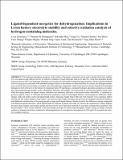Ligand-Dependent Energetics for Dehydrogenation: Implications in Li-Ion Battery Electrolyte Stability and Selective Oxidation Catalysis of Hydrogen-Containing Molecules
Author(s)
Giordano, Livia; Østergaard, Thomas M.; Muy, Sokseiha; Yang, Yu; Charles, Nenian; Kim, Soo; Zhang, Yirui; Maglia, Filippo; Jung, Roland; Lund, Isaac; Rossmeisl, Jan; Shao-Horn, Yang; ... Show more Show less
DownloadGiordano_ChemistryMaterials_2019.pdf (3.159Mb)
Publisher Policy
Publisher Policy
Article is made available in accordance with the publisher's policy and may be subject to US copyright law. Please refer to the publisher's site for terms of use.
Terms of use
Metadata
Show full item recordAbstract
The hydrogen adsorption energetics on the surface of inorganic compounds can be used to predict electrolyte stability in Li-ion batteries and catalytic activity for selective oxidation of small molecules such as H₂ and CH₄. Using first-principles density functional theory (DFT), the hydrogen adsorption was found to be unfavorable on high-band-gap insulators, which could be attributed to a lower energy level associated with adsorbed hydrogen relative to the bottom of the conduction band. In contrast, the hydrogen adsorption was shown to be the most favorable on metallic and semiconducting compounds, which results from an electron transfer from adsorbed hydrogen to the Fermi level or the bottom of the conduction band. Of significance, computed hydrogen adsorption energetics on insulating, semiconducting, and metallic oxides; phosphates; fluorides; and sulfides were decreased by lowering the ligand p band center, while the energy penalty for ligand vacancy formation was increased, indicative of decreased surface reducibility. A statistical regression analysis, where 16 structural and electronic parameters such as metal–ligand distance, electronegativity difference, Bader charges, bulk and surface metal and ligand band centers, band gap, ligand band width, and work function were examined, further showed that the surface ligand p band center is the most accurate single descriptor that governs the hydrogen adsorption tendency, and additional considerations of the band gap and average metal–ligand distance further reconcile the differences among compounds with different ligands/structures, whose ligand bands are different in shape and width. We discuss the implications of these findings for passivating coatings and design of catalysts and the need for novel theoretical methods to accurately estimate these quantities from first principles. These results establish a universal design principle for future high-throughput studies aiming to design electrode surfaces to minimize electrolyte oxidation by dehydrogenation in Li-ion batteries and enhance the H–H and C–H activation for selective oxidation catalysis.
Date issued
2019-07Department
Massachusetts Institute of Technology. Research Laboratory of Electronics; Massachusetts Institute of Technology. Department of Mechanical Engineering; Massachusetts Institute of Technology. Department of Materials Science and EngineeringJournal
Chemistry of Materials
Publisher
American Chemical Society (ACS)
Citation
Giordano, Livia et al. "Ligand-Dependent Energetics for Dehydrogenation: Implications in Li-Ion Battery Electrolyte Stability and Selective Oxidation Catalysis of Hydrogen-Containing Molecules." Chemistry of Materials (July 2019): 5464–5474 © 2019 American Chemical Society
Version: Author's final manuscript
ISSN
0897-4756
1520-5002